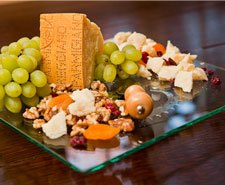High-Calcium Foods and Your Health
Calcium is the most abundant mineral in our bodies. Literally, it keeps us on our feet because 99 percent is stored in our bones and teeth. Calcium is essential not only for bone growth and strength, but for blood clotting, muscle contraction and transmission of nerve signals, helping to control blood pressure and maintain your heart beat. This is where the remaining 1% of calcium is used.
When our diets fail to provide enough calcium, our bodies steal it from the bones, which can lead to bone loss and eventually the risk of osteopenia or osteoporosis. That’s why we need to replenish our stores every day.
 Parmesan as a Calcium Source
Parmesan as a Calcium Source
Just one ounce of Parmigiano Reggiano® cheese, a milk-based food, supplies approximately one-third of the typical adult’s recommended Daily Value of 1000 milligrams. For preteens, teens, pregnant women, women between 50 and 70, and men and women over 70 who need a higher intake of calcium, Parmesan can play an even more important role.
In addition to cheese and other dairy products, calcium is available in leafy green vegetables such as kale and in calcium-enriched juices and soy products.
Absorption of Calcium
In general, the body absorbs calcium naturally occurring in foods more readily than from supplements. Dairy products, which come from animal sources, are a rich source of calcium. Nutrients coming from foods provide not only vitamins and minerals, but also dietary fiber and other substances that occur naturally. These substances coming from foods may be beneficial to your health.
An adequate intake of vitamin D is important for proper absorption of calcium into the body. Fifteen minutes of sunlight supplies the daily requirement for vitamin D. Alternatively, people can reach the recommended 600 international units (IU) a day by eating fatty fish such as tuna or salmon, drinking vitamin D-fortified products such as orange juice or taking a supplement containing vitamin D.
Groups Who Need Extra Calcium
Preteens and Teens
Peak bone mass refers to the genetic potential for bone density. By the age of 30, the average person has acquired most of that skeletal mass. That’s why it’s so important for young people to build bone mass. During their preteen and teen years, they need 1300 milligrams of calcium per day to achieve this goal.
Women
 Because they have smaller frames than men, women are at special risk for bone-loss diseases—but there’s good news. Even though the pace slows, they can continue to build bones until age 30. During pregnancy and breast-feeding, they should set their calcium quota at 1300 milligrams.
Because they have smaller frames than men, women are at special risk for bone-loss diseases—but there’s good news. Even though the pace slows, they can continue to build bones until age 30. During pregnancy and breast-feeding, they should set their calcium quota at 1300 milligrams.
After menopause, reduced levels of estrogen can result in serious bone loss unless it is counteracted by consuming adequate amounts of calcium which can slow bone loss. Postmenopausal women should consume 1200 milligrams of calcium daily.
Seniors
As noted above, postmenopausal women should boost their calcium intake to fight the effects of bone loss. After age 70, people of both sexes begin to lose muscle and bone mass. For this reason, both men and women should consume calcium at the 1200 milligram-a-day rate.
A lesson could be taken from the example of astronauts who, because of their gravity-free environment, are similarly at risk of bone loss. The crew of the International Space Station eats 3 ½ ounces of Parmigiano Reggiano daily—think what just one ounce could do for your health!
Action Steps to Prevent Bone Loss
Incorporate calcium-rich foods into your daily menu. Start with a breakfast burrito of scrambled eggs with salsa and grated Parmesan, wrapped in a flour tortilla. Grated or cut in shards with a vegetable peeler, Parmesan is delicious on soups, salads and pasta.Get the right amount of vitamin D (400 -800 IU) for all healthy individuals, to promote proper absorption of calcium.Participate in weight-bearing exercise such as walking, running, dancing and resistance training.Avoid smoking and excessive alcohol consumption.
Calculating Your Calcium Needs
Get Enough Calcium for Your Age
The National Academy of Sciences recommends getting enough calcium for your age. This is easier than you think.
Six Ways to Prevent Bone Loss
- Get enough calcium for your age.
- Take 400 to 800 IU of vitamin D supplement a day when you can’t spend time in the sun.
- Engage in weight-bearing exercise (walking, dancing, free weights).
- Take medications, if needed, as recommended by your physician.
- Avoid excessive alcoholic beverage consumption.
- Avoid smoking.
Tip for Label Readers: 1000 mg is the FDA % Daily Value for calcium. So when you read on the label that a food contains a certain percentage of calcium just multiply that number by ten to get the mg amount (i.e. one ounce of Parmigiano Reggiano contains 30% DV calcium x 10 = 300 mg calcium.